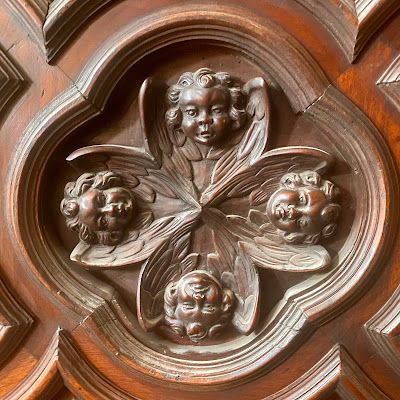The weekend before we arrived in Mexico City, more than a hundred thousand people gathered in the Plaza de la Constitucion to protest measures that would weaken election integrity but it was practically empty the morning we visited.
The plaza sits atop Tenochtitlan, an ancient Mesoamerican city destroyed by the Spanish in the 16th century. In the late 1970s, archaeologists uncovered the remains of Templo Mayor, first constructed 650 years earlier and rebuilt six times. It's just a few steps away from the sprawling Catedral Metropolitana de la Asunción de la Bienaventurada Virgen María a los cielos. In other words, this area has a LOT of continuing history.
Morning mass prevented us from seeing much of the ornate cathedral, built in a mishmash of styles over more than two centuries. It's also sinking, as are many other buildings in Mexico City due to the instability of the soft clay ground and a water table that keeps dropping. Still there was plenty of devotional eye candy to be found, some of it for sale.
One hunky saint struck a pose. It turns out he's the namesake of an even older baroque church we visited later in the trip.
I can't remember if this statue depicts a saint or a pope. In any case, he looked more than a little cast aside.
Souvenir vendors had just begun displaying their cheap trinkets on blankets lining the plaza.
Men dressed like Aztecs performed bogus purification rites for tips.
Although we didn't use public transportation, I never felt threatened anywhere we went. Police, including these three women who insisted on pulling up their masks before allowing me to photograph them, patrol tourist sites.
Workers never know what relics they may uncover when digging up the streets.
We briefly explored a mall filled with stores specializing in liturgical goods. This Jesus had a bad hair day.
At the Museo de Caricatura, a friendly, welcoming artist displayed the Charlie Chaplin he sketched for a bookmark that I bought. Unfortunately, there wasn't much else to see.
This statue honors Itzcoatl, a fierce 15th-century warrior who established an alliance with two other Mesoamerican kings that became the basis for the Aztec empire.
Chris perused the stalls outside a major book fair.
City residents have been mailing letters and buying stamps at the palatial post office--among many monumental buildings commissioned by President Porfirio Diaz, the de facto dictator who opened Mexico up for foreign investment during his seven terms in the late 19th century--for more than a century.
This postal delivery bike is part of a small, ground-floor museum.
Museo de Franz Meyer houses Latin America's largest collection of decorative arts in a former seminary and hospital. Assembled by a German stockbroker who fell in love with Mexico, eventually becoming a naturalized citizen, the ever changing items are well-lit and thoughtfully displayed, especially in contrast to the Museo Soumaya.
Our third interior courtyard of the day (after Secretaria de Educacion Publica and Antiguo Colegio de San Ildefonso) turned out to be the loveliest. After ordering snacks from the cafe, we sat at a table outside, next to an extraordinarily handsome young man who was poring over Don Quixote. The museum's small but gorgeous library has more than five hundred editions of Cervantes' epic novel, completed almost exactly one century after the Spanish defeated the Aztecs. I read it in college and have been tilting at windmills ever since.

























No comments:
Post a Comment